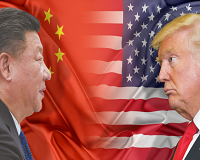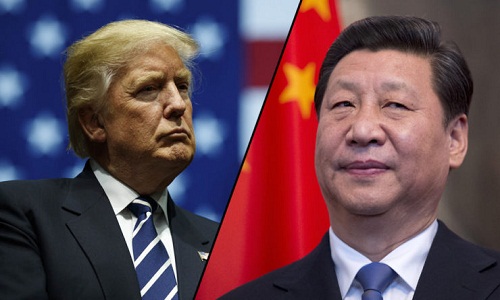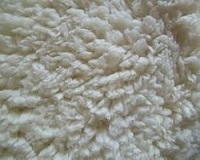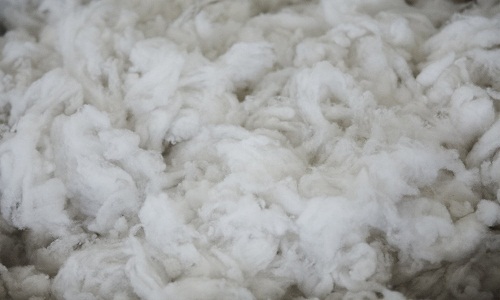FW
Cotton prices have increased from around Rs 350 to Rs 400 per quintal and are likely to remain high due to an increase in international market prices. According to P Alli Rani, CMD, Cotton Corporation of India (CCI), cotton prices usually increase during this time in the season due to slowdown in arrival. And with increasing demand from spinning mills and ginners, these prices are likely to remain firm for sometime.
So far, 320 lakh bales have arrived in the market and the season is likely to continue for another 30 days. Arrivals have slackened to 0.5 lakh bales a day, thus increasing the prices. According to cotton ginners, market sentiment is positive due to the speculation that demand from China is surging due to depleting buffer stock. China, earlier, had a buffer stock for one-and-a-half years and this has now reduced to a year’s stock. Exports from India, therefore, are likely to touch 75 lakh bales instead of the originally estimated 65 lakh bales.
The textile industry in India may be made to buy cotton and jute from farmers at least at the minimum support prices. This move is part of efforts to ensure a 50 per cent profit to farmers over their cost of production. The proposal — fraught as it is with serious implementation challenges — could spell trouble for the labor-intensive textile and garment industry.
MSP for cotton will increase by at least 28 per cent in 2018-19 from the current level. Cotton accounts for roughly 60 per cent of yarn costs and yarn makes up for 50 per cent of fabric costs. Fabric, in turn, makes up for 50 per cent of garment costs. So higher cotton prices will push up costs in the entire value chain and jeopardise its competitiveness.
The idea is being mooted at a time when garment production has dropped for 11 months in a row and exports have contracted for a seventh straight month through April, with most units reeling under elevated costs.
Garment production dropped 11 per cent in 2017-18 and exports contracted almost four per cent even though the country’s overall merchandise exports rose 9.8 per cent. Also, the proposal will potentially render the Cotton Corporation of India irrelevant.
Avantex Paris will take place from September 17 to 20, 2018. This is a platform dedicated to sourcing for the high-tech fashion industry, to promote their innovative services or products related to fashion and textiles. It puts innovation at the heart of reflection, highlighting prospective visions and proposals about the fashion industry through roundtables and animations, brings together experts and well-known players of the industry, from source to end-user and from fibers to finished products, and features the latest research and innovations that contributes to a more sustainable fashion.
The show will showcase digital printing and textile printing equipment and services as well as innovative dyes. On display will also be e-clothing, e-accessories, developed by start-ups, schools, incubators, designer labels etc. Exhibitors will also showcase new fibers (new properties: water repellence, reflecting retro surfaces, etc.), conductive fibers, threads, surfaces, biotech textiles, innovative inks (conductive, thermochromic, etc.), advanced textiles, flexible or adaptive embedded systems for textiles (batteries, RFID, sensors, flexible boards, etc.), and smart components.
Avantex Paris was launched in France in 2015 by Messe Frankfurt France. The mutations brought about by technology have created a true revolution and new challenges for fashion designers: technology must enhance fashion while, at the same time, serving the consumer.
"Therefore, the reasons for China’s protest are perfectly valid. After all, the country has achieved phenomenal success in globalisation through selective protection, credit subsidies, state-owned enterprises, domestic-content rules, and technology-transfer requirements. Although the US has alleged that Chinese policies violate WTO rules, it still cannot be called a trade cheat as the country would not have been able to diversify its economy and grow as rapidly had it become a WTO member before 2001."
 The ongoing US-China spat reached a dead-end when a high-profile United States trade delegation returned empty-handed from its mission in China. This wasn’t surprising as US demands were not only unfair but also highly unjust. The Americans wished to completely revamp Chinese industrial policies and intellectual property rules, besides refraining the Chinese government from retaliating against Trump's proposed unilateral tariffs against Chinese exports.
The ongoing US-China spat reached a dead-end when a high-profile United States trade delegation returned empty-handed from its mission in China. This wasn’t surprising as US demands were not only unfair but also highly unjust. The Americans wished to completely revamp Chinese industrial policies and intellectual property rules, besides refraining the Chinese government from retaliating against Trump's proposed unilateral tariffs against Chinese exports.
Therefore, the reasons for China’s protest are perfectly valid. After all, the country has achieved phenomenal success in globalisation through selective protection, credit subsidies, state-owned enterprises, domestic-content rules, and technology-transfer requirements. Although the US has alleged that Chinese policies violate WTO rules, it still cannot be called a trade cheat as the country would not have been able to diversify its economy and grow as rapidly had it become a WTO member before 2001.
Playing the right game
China plays the globalisation game by Bretton Woods rules. As a Chinese official once explained, their strategy is to open the window but place a screen on it. They get the fresh air (foreign investment and technology) while keeping out the harmful elements (volatile capital flows and disruptive imports).
it. They get the fresh air (foreign investment and technology) while keeping out the harmful elements (volatile capital flows and disruptive imports).
Chinese practices are not very different from that of other advanced countries yet one of the major US complaints is that the Chinese systematically violate intellectual property rights to steal technological secrets. It is imperative for international trade regimes to accept the unfeasibility and undesirability of restricting the policy space other countries have. Levels of development, values, and historical trajectories differ too much for countries to be shoehorned into a specific model of capitalism. Sometimes domestic policies backfire, eliminating foreign investors out and impoverishing domestic economy. At other times, they propel economic transformation and poverty reduction, as is in the case of China.
Unsolicited restrictions
International trade rules cannot discriminate between these two sets of circumstances as they are a result of painstaking negotiations among diverse interests - including, corporations and their lobbies. Countries pursuing harmful policies endanger themselves; since if these strategies go wrong, the home economy pays the steepest price. So, although many liberal commentators rightly support the US, it can’t be denied that Trump's trade agenda is driven by a narrow mercantilism that privileges the interests of US corporations over other stakeholders. It shows little interest in policies that would improve global trade for all. Such policies should start from the trade regime's Golden Rule: do not impose on other countries constraints that you would not accept if faced with their circumstances.
"Woolgrowers at the event said, production has serious limitations. In Australia, the producer of over 80 per cent of the world fine apparel wool, production growth is limited by the lack of Merino ewes, the high lamb and mutton price, poor seasons, wild dog predation, land committed to cropping and in some cases a lack of infrastructure and even expertise amongst prospective woolgrowers. In New Zealand, land suitable for Merino wool growing is limited partly due to similar factors in Australia but also the drive to preserve some high-country areas for conservation."
 AWI, in its monthly report, examined the global and domestic state of the wool industry in light of the recent World Merino Congress in Montevideo, Uruguay, coupled with record prices at Australian wool sales and a recent Australian wool production forecast.
AWI, in its monthly report, examined the global and domestic state of the wool industry in light of the recent World Merino Congress in Montevideo, Uruguay, coupled with record prices at Australian wool sales and a recent Australian wool production forecast.
The World Merino Conference was held in May 2018 in Montevideo, Uruguay. It was attended by over 400 delegates from Australia, New Zealand, South Africa, Uruguay, Argentina, Lesotho, Russia, United States and Portugal. Despite the optimism that the conference hoped to convey, there was a hint of pessimism given the Merino wool producing countries’ inability to lift production.
Socio-political limitations
Woolgrowers at the event said, production has serious limitations. In Australia, the producer of over 80 per cent of the world fine apparel wool,  production growth is limited by the lack of Merino ewes, the high lamb and mutton price, poor seasons, wild dog predation, land committed to cropping and in some cases a lack of infrastructure and even expertise amongst prospective woolgrowers. In New Zealand, land suitable for Merino wool growing is limited partly due to similar factors in Australia but also the drive to preserve some high-country areas for conservation.
production growth is limited by the lack of Merino ewes, the high lamb and mutton price, poor seasons, wild dog predation, land committed to cropping and in some cases a lack of infrastructure and even expertise amongst prospective woolgrowers. In New Zealand, land suitable for Merino wool growing is limited partly due to similar factors in Australia but also the drive to preserve some high-country areas for conservation.
In South Africa, political changes, predation and indeed the development of some areas to mining is impacting growth potential and in Argentina major predation by foxes and pumas are limiting weaning rates to less than 70 per cent for many Merino producers. Wool-growing regions of Patagonia, Argentina have only recently recovered from significant volcanic activity in Chile so there is a myriad of reasons why the global supply of wool is not about to lift significantly, despite the relatively favourable market.
Value for money
Wool price as represented by the EMI has traditionally traded at three to four times the price of cotton as represented by the Cotlook A index and this can be seen above when examining the first 10 years of the graph when comparing the white line of the EMI relative to the orange line of the Cotlook A index. In fact, all fibres other than wool: cotton, acrylic, nylon and polyester, have traded in a band of prices that appear rather flat relative to wool since 2001. The exception is the price spike in late 2010, early 2011 that effected both wool and cotton. One very clear trend when comparing wool to these man-made and commodity fibres is the relative price ratios beyond around 2013-14. Over the past 4-5 years the EMI has clearly pulled away from these fibres, so much so that the current market shows that wool:cotton ratio is currently closer to 7:1 rather than the traditional 3-4:1. It is clear that wool is now perceived as a more valuable fibre relative to cotton, nylon, polyester, acrylic and nylon.
The bottom line is world’s consumers, those who ultimately set the price for wool at the cash register, are willing to pay a premium for Merino wool as a renewable but rare natural fibre and unless consumers know about wool and its superior natural benefits, they will not demand it let alone pay a significant premium for it over these man-made and cellulosic fibres.
Manmade fabric hub of Surat wants traders and weavers to be removed from the purview of GST. The output of manmade fabric has come down from around four crore meters a day to less than two crore meters in the July-April 2017-18 period, ie post implementation of GST.
Sale of polyester fabric, including saris and dress material, has reduced by nearly 40 per cent, and the export of finished fabrics has decreased by around 28 per cent in the first ten months since GST was implemented on July 1, 2017. More than 90,000 power loom machines have been sold in scrap during the ten-month period, as import of fabric from China and other countries has become cheaper.
Since July 1 last year, over 60,000 embroidery machines have been shut rendering thousands of women jobless. First, the withdrawal of high-value currency notes paralysed Surat as its economy is largely cash-based involving small processors and migrant employees. Then GST rendered a big blow to textile processors, whose cost increased sharply along with compliance burden.
Since yarn is not woven, and fabric is not produced, job workers do not have much processing work. Following the rise in crude oil prices, prices of petrochemicals are also rising. These are raw materials for producing polyester yarn used by Surat-based power looms.
Compared to last year, Pakistan’s textile exports have managed to continue recovering in the 10MFY18 period with modest growth of 8 per cent. The segments that contributed the most to this growth in value terms were knitwear and readymade garments, registering an increase of almost 15 and 12 per cent respectively.
This year’s growth in textile exports has mostly been based on a boost in the value added segments. Readymade garments have also increased by 13.5 per cent. However, the state of overall sector remains mired with problems which continue to hamper growth. The outgoing government has left it in some cases to the last months of its tenure to address issues which have been red-flags for some time now.
The government has failed to address the issue as gas provision to majority of Punjab-based textile industry has been R-LNG. This costs almost Rs 1200/MMBTU and unless a weighted average formula is adopted by the next government, matters would become grimmer in the time to come.
Similarly, the government has realized in its final days high power tariffs for the textile sector are counter-productive and there are talks of bringing down the electricity tariff by Rs 3. Association (PTEA), not even a single processed sales tax refund claim has been paid for 8 months while huge amount of sales tax RPOs is also pending payment. The only thing that can be determined for a certainty is that the PML-N government did things too little and too late for recovery of the textile sector.
India International Knit Fair (IIKF) was held in Tirupur from May 16 to 18, 2018. The spotlight was on spring/summer 2018 with a complete display of latest fashion wear. This time, the fair was comparatively a dull show. The apparel sourcing fair witnessed only 30 companies displaying latest offerings. The event also witnessed a low footfall from the buying community.
In spite of the perfect venue, participation by top exporters displaying their diverse products’ range, tickets and the stay (hospitality) support given to visiting buyers, the visitation on all three days -- be it from overseas buyers or Indian buying houses – was limited.
Tirupur is the knitwear capital of India. Witnessing the worst decline in last three decades, Tirupur’s apparel export industry recorded business worth Rs 23,000 crores during the last financial year, significantly less when compared to Rs 26,000 crores the previous year.
IIKF has emerged as one among of the most reputed knitwear trade fairs in the world. It aims to showcase end-to-end products pertaining to the knitwear segment. India Knit Fair Association has been conducting the India International Knit Fair for 21 years with the objective of presenting the capabilities of knitwear items from India.
Austria’s Starlinger Group will takeover the German business unit from Chemnitz also known under the brand name Barmag Spinnzwirn. The technologies for selected high speed winders and precision winders for special applications like aramid or carbon will be sold to Starlinger as well. The business unit has a very solid international customer base with long-standing successful relationships. In 2015, a new, innovative technology centre for R&D and the performance of customer experiments was put into operation. The Chemnitz site currently employs about 160 members of staff.
Another market success for the Chemnitz branch of the German parent company Oerlikon Textile is the recently launched automatic winders, WinTape and WinTape XXL as well as the EvoTape process for film extrusion lines.
Barmag Spinnzwirn has been successfully confirmed in the market as a technology trendsetter over the last decades. The Oerlikon manmade fibers segment unit provides its extrusion plants for the production of tape and monofilaments for polypropylene, polyethylene, polyamides and polyester as turnkey plant-design solutions.
The resulting synergies in technical as well as commercial terms will underpin Starlinger’s leading position in the world of textile packaging and its applications and lead to new, innovative and customer oriented solutions in the medium term.
Apparel Textile Sourcing Show was held in Miami from May 21 to 23.This is an apparel and textile sourcing trade show. It welcomed top apparel and textile manufacturers from over 15 regions, top brands, retailers, designers and sourcing professionals from China, Bangladesh, India, Pakistan, Mexico,El Salvador, Honduras, Peru, the US. Over 3,500 visitors attended.
The product categories covered apparel and textiles from fashion to function, from leather to lace. Categories included finished apparel for men, women, and children that range from leisure, formal, denim, active, swim, intimates, and performance. Exhibitors also displayed home ware and linen, hardware, and textiles that included cotton, knits, yarns, leather, synthetics and blends.
Various seminars addressed a comprehensive range of topics including sustainability, global sourcing, supply chain, social compliance, influencer marketing, and branding strategies. Sessions were presented by industry experts, top educators, respected designers, influential bloggers and economists.
The show also saw inspirational leaders, and respected industry experts from the apparel, manufacturing, retail, and affiliated business industries to educate, network, share market intelligence, discuss pressing topics and engage in conversations that energize the flow of global commerce. Over 200 international and domestic manufacturing firms presented a range of products and process solutions in the field of manufacturing and sourcing services.












